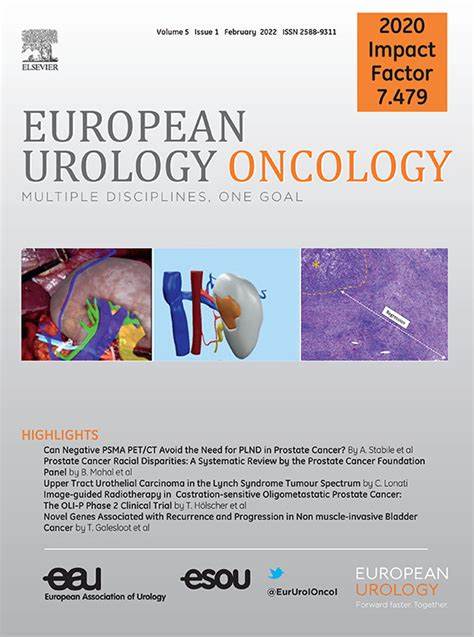放射治疗在肌肉浸润性膀胱癌原位癌的治疗中的应用:仍不可行?
IF 9.3
1区 医学
Q1 ONCOLOGY
引用次数: 0
摘要
背景和目的:本综述探讨原位癌(CIS)对肌肉浸润性膀胱癌(MIBC)经尿道膀胱肿瘤切除术、放射增敏剂和放射治疗(RT)三模式治疗(TMT)后预后的影响。CIS通常被认为是TMT的禁忌症,但其对治疗效果的影响证据有限且不一致。方法:我们回顾了评估TMT和RT单独对cis相关性MIBC临床结果影响的研究。评估的终点包括完全缓解(CR)率、总生存期(OS)、疾病特异性生存期(DSS)和放疗方案的变化,如分治计划、总剂量和图像引导下放疗的使用。主要发现和局限性:单独放疗研究的证据不一致,通常是因为过时的治疗方案和不充分的CIS评估。回顾性TMT研究表明,CIS对CR率没有显著影响,尽管其对OS和DSS的影响仍不确定,特别是在次优RT方案下。新出现的证据支持持续和中度低分割RT结合图像引导RT作为改善预后的潜在策略。广泛CIS的标准化定义和更好的患者选择对于优化膀胱保存策略至关重要。结论和临床意义:CIS对MIBC的TMT提出了重大挑战,需要精确的评估、先进的RT技术和多学科合作。新的治疗方法,包括免疫治疗和膀胱内用药,可能会进一步改善预后。标准化方案的研究对于优化治疗策略至关重要。本文章由计算机程序翻译,如有差异,请以英文原文为准。
Radiation Therapy in the Management of Muscle-invasive Bladder Cancer with Carcinoma in Situ: Still a No Go?
Background and objective
This narrative review explores the impact of carcinoma in situ (CIS) on outcomes in muscle-invasive bladder cancer (MIBC) after trimodal therapy (TMT) comprising transurethral resection of bladder tumor, a radiosensitizing agent and radiation therapy (RT). There is limited and inconsistent evidence on the effect of CIS, often considered a contraindication to TMT, on treatment efficacy.
Methods
We reviewed studies evaluating the influence of TMT and RT alone on clinical outcomes in CIS-associated MIBC. Endpoints evaluated included complete response (CR) rates, overall survival (OS), disease-specific survival (DSS), and RT protocol variations, such as fractionation schedules, total doses, and the use of image-guided RT.
Key findings and limitations
Evidence from studies on RT alone is inconsistent, often because of outdated regimens and inadequate CIS evaluation. Retrospective TMT studies suggest that CIS does not significantly affect CR rates, although its impact on OS and DSS remains uncertain, particularly with suboptimal RT protocols. Emerging evidence supports continuous and moderately hypofractionated RT combined with image-guided RT as potential strategies to improve outcomes. Standardized definitions of extensive CIS and better patient selection are critical for optimizing bladder preservation strategies.
Conclusions and clinical implications
CIS presents significant challenges for TMT in MIBC, necessitating precise assessment, advanced RT techniques, and multidisciplinary collaboration. Novel therapies, including immunotherapy and intravesical agents, may further improve outcomes. Research into standardized protocols is essential to optimize treatment strategies.
求助全文
通过发布文献求助,成功后即可免费获取论文全文。
去求助
来源期刊

European urology oncology
Multiple-
CiteScore
15.50
自引率
2.40%
发文量
128
审稿时长
20 days
期刊介绍:
Journal Name: European Urology Oncology
Affiliation: Official Journal of the European Association of Urology
Focus:
First official publication of the EAU fully devoted to the study of genitourinary malignancies
Aims to deliver high-quality research
Content:
Includes original articles, opinion piece editorials, and invited reviews
Covers clinical, basic, and translational research
Publication Frequency: Six times a year in electronic format
 求助内容:
求助内容: 应助结果提醒方式:
应助结果提醒方式:


